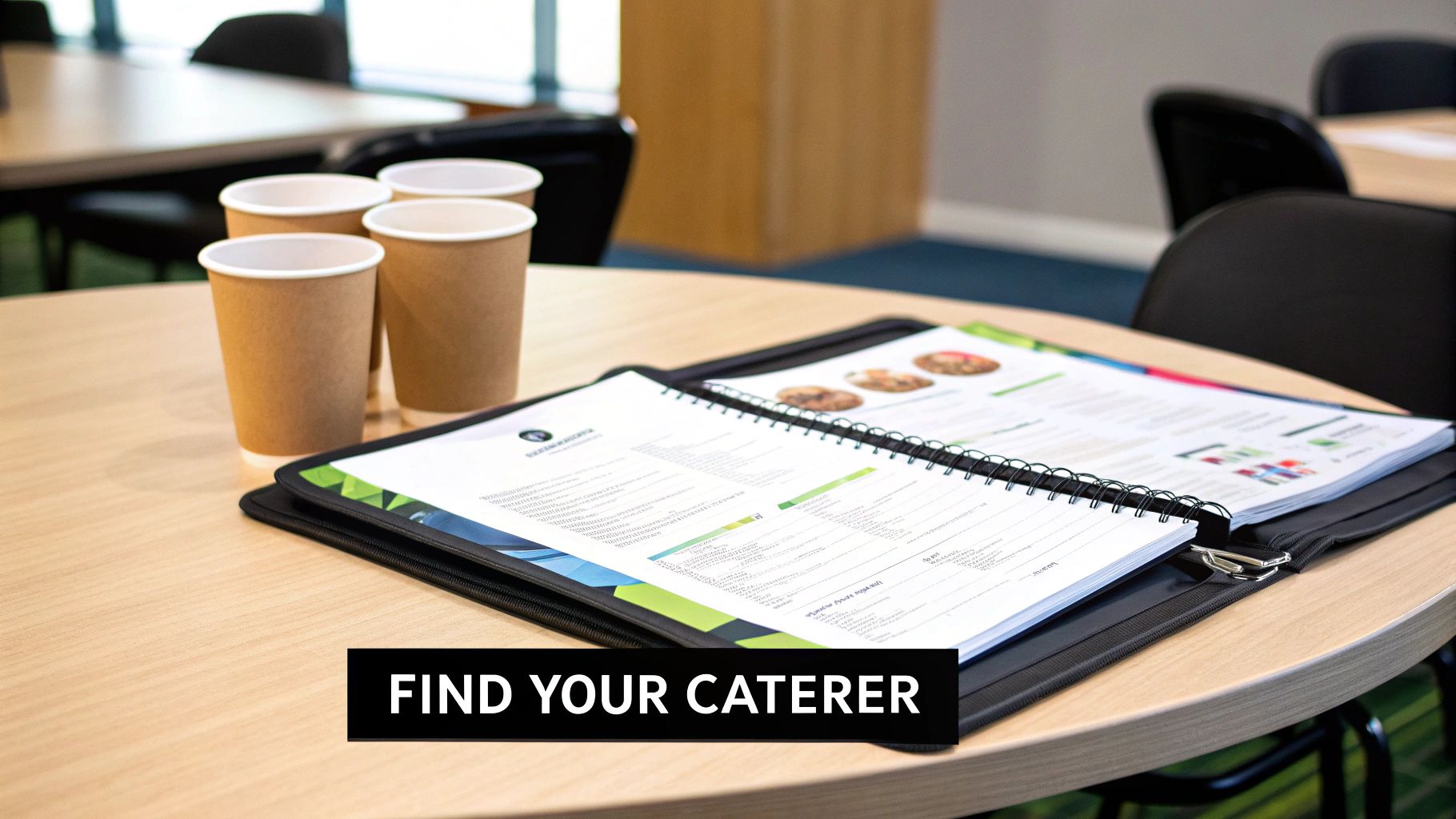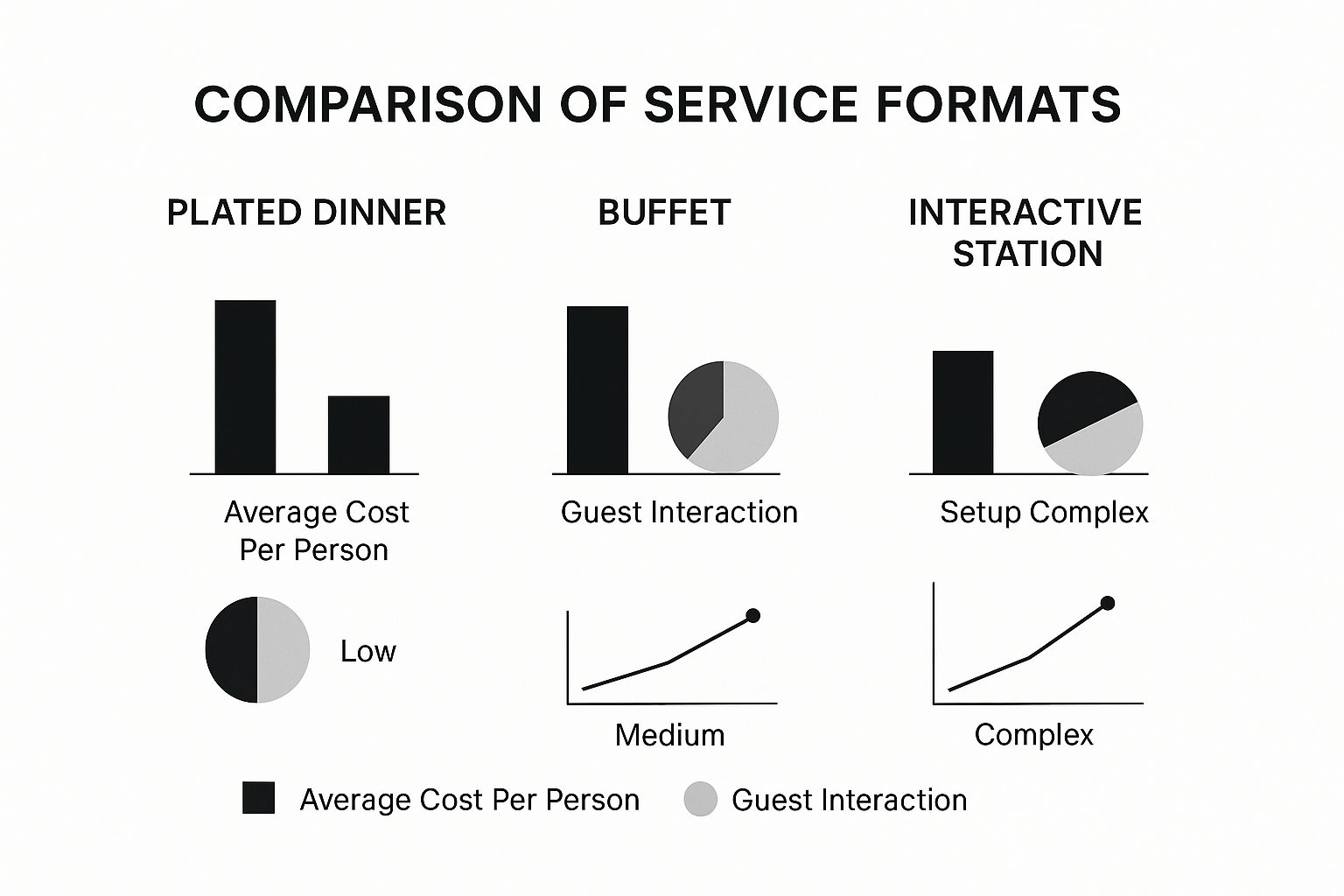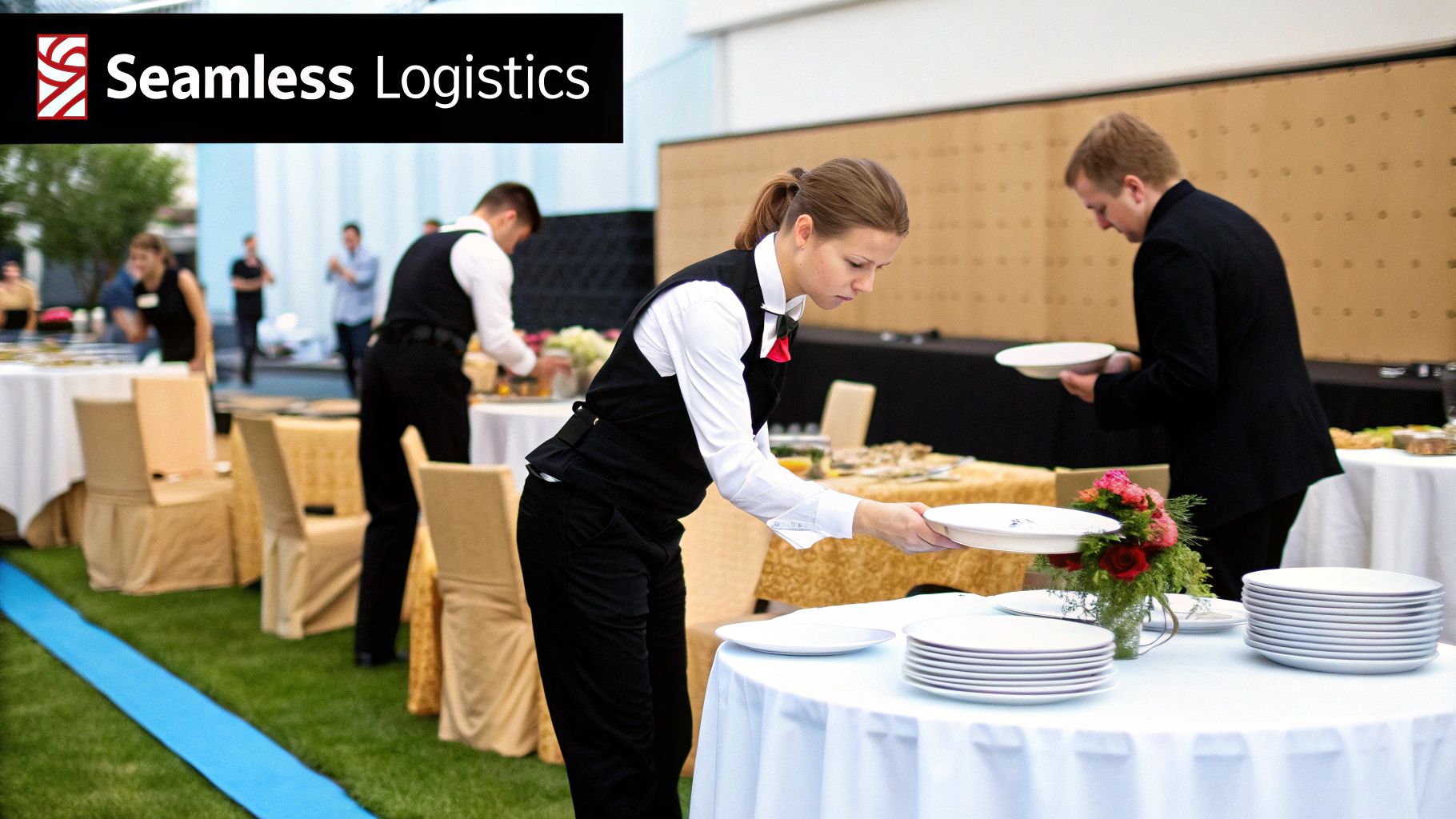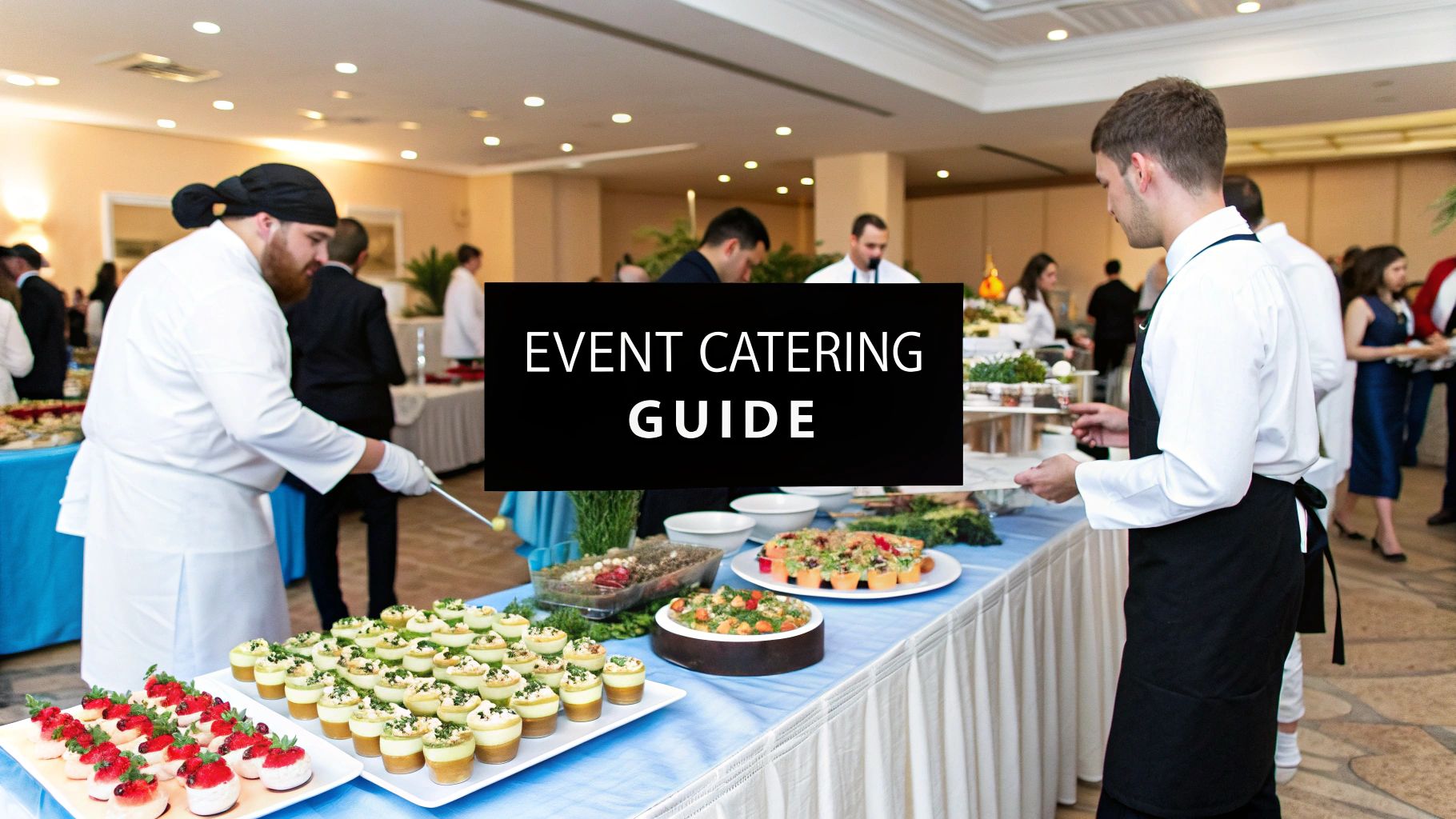When you think about event catering, it's not just about providing food and drinks. It’s about creating an experience. Whether you're planning a small office get-together or a massive wedding, getting the catering right is crucial. It’s what turns a simple meal into a highlight of the occasion, and it all starts with a solid plan covering your budget, guest list, menu, and all the little logistical details.
Building the Blueprint for Your Event's Catering

Great event catering doesn't just happen by chance. It's the product of a well-thought-out blueprint. Before you even start dreaming about tasting menus or comparing caterers, you need to lay the groundwork. This is the stage where you ground your vision in reality, ensuring every decision that follows is smart and strategic.
Think of it like sketching the architectural plans for a house. You wouldn't just start hammering nails without knowing the budget, the size of the rooms, or the overall style. The same logic applies here. Every choice, from the service style to the flavour of the main course, should tie directly back to this initial plan.
What’s the Vibe? Defining Your Vision and Scope
First things first: what is this event all about? Is it a formal corporate gala, a celebratory wedding, or a casual team-building lunch? The answer to that question will shape the entire atmosphere. An elegant fundraising dinner calls for a completely different catering approach than a laid-back company picnic.
Your vision sets the tone for everything. Nail down these foundational pieces:
- The Atmosphere: Are you going for sophisticated and formal, or relaxed and interactive? This directly impacts your service style. Plated dinners feel more traditional, whereas food stations are fantastic for encouraging guests to mingle.
- The Guest Experience: What do you want your guests to remember? The food should be a seamless part of that experience. For a networking event, easy-to-handle canapés make a lot more sense than a sit-down meal that requires a knife and fork.
- The Timeline: The flow of your event dictates the food service. A cocktail hour needs appetizers ready to go, while an all-day conference might require breakfast, lunch, and a couple of coffee breaks to keep energy levels up.
Before you reach out to a single vendor, it helps to have your foundational details mapped out. This simple checklist ensures you're prepared with the right information.
Initial Catering Planning Checklist
| Planning Element | Key Questions to Answer | Example Scenario (Corporate Gala) |
|---|---|---|
| Event Purpose | What is the primary goal of this event? (e.g., celebration, networking, fundraising) | To celebrate company achievements and honour top performers. |
| Guest Count | What is your confirmed number of guests? What's the potential maximum? | 250 confirmed guests, with a potential maximum of 275. |
| Event Date & Time | When is the event, and what is the full timeline (start to finish)? | Friday, October 25th, from 6:00 PM (cocktail hour) to 11:00 PM. |
| Venue Details | Where is it? Does the venue have a kitchen? Are there any restrictions? | The Grand Ballroom downtown. It has a full catering kitchen but an exclusive beverage provider. |
| Atmosphere | What is the desired tone? (e.g., formal, casual, festive) | Formal and sophisticated. Black-tie dress code. |
Having these answers ready not only makes your initial conversations with caterers more productive but also helps them provide a much more accurate and relevant proposal from the get-go.
Creating a Detailed Guest Profile
Knowing your audience is everything. A guest profile is more than just a headcount and a list of allergies; it's about anticipating what your attendees will actually enjoy. This helps you and your caterer create an experience that feels truly inclusive.
For instance, a tech conference filled with a younger crowd might love trendy, build-your-own-bowl stations. On the other hand, a formal awards ceremony with international dignitaries might call for a more classic, universally appealing menu. The more you know about who’s coming, the smarter your food choices will be. This holistic approach is key, and if you're planning a corporate function, you might even consult a comprehensive guide on how to plan corporate events to make sure every element, from catering to decor, is perfectly aligned.
Nailing Down a Realistic Catering Budget
Your budget is the framework that holds your entire catering plan together. Be upfront and honest about your numbers from the very beginning—it will save you a world of headaches later. A truly realistic budget accounts for every potential cost, not just the price-per-plate.
Key Takeaway: Your total catering cost is almost always more than just the food. Remember to factor in service charges, gratuities, equipment rentals, delivery fees, and taxes to get the full picture and avoid any nasty surprises.
The catering industry itself is a perfect example of these economic forces at work. In California alone, the market has grown to an estimated $13.9 billion valuation. This reflects a powerful annual growth of 10.9% in recent years, largely fuelled by the post-pandemic boom in weddings and corporate gatherings. As a result, caterers have had to adjust their pricing to manage rising food and service costs, a trend we're seeing across the entire industry. Understanding these market dynamics will give you a better grasp of what to expect when you see the final bill.
Finding the Right Catering Partner for Your Vision

Choosing a caterer isn't just about hiring a vendor—it's about finding a creative partner who understands what you're trying to achieve. They're the ones who will bring the culinary soul of your event to life, so a quick Google search just isn’t going to cut it. You need to look past the slick websites to find someone with the experience and reliability to nail your vision.
Think of it as a bit of detective work. You’ll be digging into reviews, asking some tough questions, and making sure their style actually fits the vibe you want. A truly great caterer does so much more than just cook; they solve problems on the fly and are a huge part of your event's success.
Vetting Caterers Like a Pro
Start your search wide, then narrow it down with purpose. While online reviews and a polished Instagram feed are a good first step, they really only show you the highlight reel. To properly vet a potential caterer, you need to go deeper.
A caterer’s portfolio is their resume, so scrutinize it. Look for events that are similar to yours in size and style. If you’re planning a 300-person formal wedding, you need to see that they’ve actually handled large-scale events before, not just a string of corporate box lunches.
And don't be shy about asking for references—and then actually calling them. A quick chat with a past client can tell you more than a dozen online reviews.
- How was the communication during the planning phase?
- Was the food as good on the day of the event as it was at the tasting?
- How did the staff handle the pressure when things got busy?
These firsthand stories are gold. They give you the kind of real-world insight you’ll never find in a curated testimonial.
Asking the Right Questions During the Consultation
That first meeting is your chance to really interview a potential caterer. This conversation needs to go way beyond just looking at menus and prices. You're trying to figure out how flexible they are, what their expertise really is, and how they handle the inevitable curveballs.
For example, asking "Can you do gluten-free?" is fine. But a much better question is, "What are your exact protocols for preventing cross-contamination for a guest with celiac disease?" The level of detail in their answer will tell you everything you need to know about their experience.
Pro Tip: Always ask about their backup plans. What happens if a key chef gets sick or an oven breaks down on-site? A seasoned pro will already have contingency plans worked out, which shows they’re prepared for anything.
It's also smart to understand what's happening in the industry right now. Caterers are dealing with rising food and labour costs, and many are struggling to find skilled staff like cooks and dishwashers. Being aware of these challenges can help you have a more realistic conversation. A caterer who is transparent about how they’re navigating these issues is one you can trust.
The Art of the Tasting
The tasting is easily the most fun part of the process, but it’s also a crucial final exam for your potential caterer. This is your one and only chance to try the food before your guests do, so you have to make it count.
Go in with a plan. You're assessing more than just flavour.
- Presentation: Does the plating match the style you talked about? A dish for a rustic barn wedding should look completely different from one for a modern corporate gala.
- Temperature and Texture: Are the hot dishes actually hot? Are the cold items crisp and fresh? This is a huge indicator of whether they can execute at scale.
- Ingredient Quality: Does everything taste fresh? You can't fake quality ingredients.
Be ready to give direct, constructive feedback. Instead of just saying you don’t like something, be specific: "The chicken is cooked perfectly, but could the sauce be a little less salty?" This gives the chef clear, actionable direction. Exploring what makes a caterer stand out, like reading the top reasons Shawarma Moose is a go-to Toronto catering service, can give you more insight into what to look for. When a caterer listens and collaborates on feedback, you know you’ve found a true partner.
Designing a Menu That Tells Your Event's Story
Think of your event's menu as more than just food. It’s a core part of the experience, setting the tone and giving your guests something to talk about long after they've gone home. Getting it right is a team effort—a creative back-and-forth between your vision and your caterer's know-how.
The best menus don’t happen by accident. They're a careful blend of your event's theme, the time of year, and who you’re hosting. Every dish, from the first bite of an appetizer to the final spoonful of dessert, should feel like it belongs.
Matching Service Style to Your Event's Vibe
How you serve the food is just as important as what you serve. The service format has a huge impact on how guests mingle, how the evening flows, and the overall atmosphere you're trying to create. There’s no right or wrong answer; it’s all about what you want to achieve.
A formal, plated dinner creates a sophisticated, structured feel. It’s perfect for award ceremonies or traditional weddings where speeches are a key feature. It keeps things on schedule and ensures everyone is served at once, but it can feel a bit restrictive if you want people to move around.
Buffets, on the other hand, are all about variety and movement. They're brilliant for more casual gatherings where you want to offer a wide selection and let guests choose what they like. Just be ready for potential lines when everyone gets hungry at the same time.
Food stations take things up a notch by turning the meal into an activity. Picture a build-your-own taco bar or a chef carving prime rib right in front of your guests. These are fantastic conversation starters and bring a ton of energy to the room.
Family-style service hits that sweet spot in the middle. Big platters of food are brought to each table for everyone to share. It encourages a warm, communal atmosphere that’s ideal for smaller celebrations or team-building dinners. It's less formal than a plated meal but more organized than a buffet.
Here’s a quick breakdown of how these different styles stack up against each other, helping you weigh the pros and cons for your specific event.
Comparing Catering Service Formats
| Service Format | Best For | Pros | Cons |
|---|---|---|---|
| Plated Dinner | Formal events, weddings, award galas, and events with a tight schedule. | Elegant and sophisticated; controlled portion sizes and timing; easy to manage dietary needs. | Less guest interaction; limited food choice for guests; can be more labour-intensive. |
| Buffet | Casual to semi-formal events, large groups, and events where variety is key. | Wide variety of options; guests control their portions; encourages mingling. | Can create long queues; potential for food waste; less formal feel. |
| Food Stations | Interactive and modern events, networking receptions, and themed parties. | High guest engagement; creates a dynamic atmosphere; customizable themes. | Can be more costly; requires more space; may lead to lines at popular stations. |
| Family-Style | Intimate celebrations, team-building events, and gatherings focused on community. | Fosters a warm, communal feeling; encourages conversation; offers variety. | Can be challenging with limited table space; portioning can be uneven. |
Ultimately, the right service style will seamlessly blend with your event's purpose, whether you're aiming for black-tie elegance or a relaxed, social buzz.

Weaving in Theme and Seasonality
A menu that truly resonates feels connected to the moment. Tying your food choices to the season is a no-brainer—it guarantees the freshest, most flavourful ingredients and just feels right. A summer party calls for light salads and grilled salmon, while a winter gala is the perfect backdrop for rich, comforting braised beef and roasted root vegetables.
Your event's theme is another fantastic place to pull inspiration from.
- Rustic Wedding: Imagine farm-to-table dishes served family-style, with big baskets of artisanal bread and a simple "naked" cake for dessert.
- Modern Corporate Launch: Go for sleek, minimalist canapés, high-tech food stations, and a custom cocktail in your brand's colours.
- Tropical Beach Party: Feature fresh ceviche, vibrant fruit platters, and grilled skewers with bold Polynesian flavours.
Personalized, culturally diverse menus are more popular than ever. Corporate catering for events is a big part of this trend, with companies looking for unique food experiences to impress clients and staff. We're seeing everything from Filipino-Asian-Hawaiian fusion menus to sophisticated, plant-based spreads that wow even the most dedicated meat-eaters.
My Two Cents: Don’t be afraid to think outside the box. Your caterer is your creative partner. Give them your theme, your vision, and your budget, and let them pitch you some ideas. The best results come from collaboration.
Handling Dietary Needs with Care
In this day and age, accommodating dietary restrictions isn't just a nice-to-have; it's a critical part of being a good host. Making every single guest feel welcome and safe should be a top priority.
It all starts with clear communication. When you send out your invitations, make sure to ask guests if they have any allergies or dietary needs. Give this compiled list to your caterer well in advance, highlighting any severe allergies. Any pro will have strict kitchen protocols to avoid cross-contamination.
Clear labelling is also essential, especially for buffets and food stations. Simple signs like "Vegan," "Gluten-Free," or "Contains Nuts" help guests make safe choices without having to ask. For plated dinners, your caterer should have a discreet system for ensuring the right meal gets to the right person.
If you're looking for inspiration, our Shawarma Moose catering menu has tons of options that are easy to customize for various dietary needs. Taking these steps shows you care and ensures everyone can relax and enjoy a fantastic meal, worry-free.
Executing Flawless On-Site Catering Logistics

You can plan the most incredible menu in the world, but if the on-site execution is a mess, that’s all your guests will remember. Flawless logistics are the invisible framework holding the whole experience together, making it all feel effortless. This is where all that meticulous planning pays off, turning a good event into a truly great one.
Success on the day-of is all about coordinating the moving parts. It’s about making sure the catering team operates like a well-oiled machine, from the moment the first truck arrives until the last plate is cleared. This kind of harmony doesn't just happen by chance; it’s carefully scripted and rehearsed long before anyone walks through the door.
Crafting the Master Event Timeline
Your single most important tool for this is a detailed event timeline, or what we in the industry call a "run of show." Think of it less as a simple schedule and more as a minute-by-minute playbook that you and your caterer build together. It’s the script that choreographs every action for everyone involved with the food and beverage service.
A solid timeline maps out every critical moment, leaving no room for guesswork.
- Vendor Load-In: Pinpoint exact arrival times for the caterer, rental company, and anyone else bringing in equipment.
- Setup Period: Block out enough time for the team to set up the kitchen, stock the bar, set tables, and handle final food prep without rushing.
- Service Cues: Note the exact times for when appetizers should be passed, the buffet opens, dinner is served, and dessert comes out.
- Key Moments: Align food service with the event’s program. This means pausing service during important speeches or timing a coffee refresh just as a presentation begins.
- Breakdown and Load-Out: Schedule when staff can start clearing tables and the hard-out time when all equipment must be gone.
When everyone has access to a shared timeline, you dramatically cut down the chances of on-site confusion.
The Crucial Site Inspection
Never, ever assume a venue can handle your catering plan without doing a thorough site inspection with your caterer. This walkthrough is your chance to spot potential roadblocks and confirm the venue's capabilities before they turn into last-minute emergencies.
Walk the space with a critical eye. Is there a proper loading dock, or will the team have to haul everything through the main entrance? Where are the power outlets and water sources? These seemingly small details are fundamental to a smooth operation. A caterer who knows the layout can plan their workflow for maximum efficiency from the get-go.
Insider Tip: Pay close attention to the kitchen facilities—or the lack thereof. If your venue just has a small prep area, your caterer might need to bring in mobile ovens or extra refrigeration. That's a crucial detail that directly impacts both your budget and your logistics plan.
Coordinating with Your Vendor Team
Your caterer doesn’t operate in a vacuum. They’re a key player on a bigger team that includes the venue manager, a rental company, a florist, and maybe a DJ or band. For a truly cohesive event, open communication between all these vendors isn't just nice to have; it's non-negotiable.
For example, the rental company needs to know exactly when to drop off tables so the catering staff can get the linens on. The florist has to coordinate with the caterer to place centrepieces after the linens are down but before the glassware is set. A simple introduction between your key vendors early on helps build a collaborative spirit.
A quick pre-event call with all the vendor leads can iron out potential conflicts and confirm everyone is working off the same master timeline. It's also worth looking into the latest hospitality technology trends, which can offer some great ideas for creating a more modern and streamlined experience for everyone.
Getting Staffing Levels Just Right
Understaffing is one of the fastest ways to sour the guest experience. Nothing kills the mood like a long line at the bar, tables cluttered with dirty plates, or an empty buffet station. You need to work closely with your caterer to figure out the right staffing levels for your specific event.
Here are a few good rules of thumb to start with:
- Buffet Service: You'll generally want 1 server for every 25-30 guests. They'll keep the buffet line tidy, fully stocked, and clear guest tables.
- Plated Dinner: This requires more hands-on service, so aim for 1 server per 1-2 tables (which is about 8-16 guests).
- Bartenders: Plan for 1 bartender per 50-75 guests to keep the drinks flowing and the lines from getting too long.
And don't forget the people behind the scenes! You'll also need kitchen staff, a catering manager to run the show, and a dedicated cleanup crew. Getting the right number of people in the right roles is a direct investment in the quality of your catering for events. If you're planning for a larger group and want to keep things simple, looking into buffet-style office catering can be a great way to streamline both your staffing and logistical needs.
Finalizing Contracts and Avoiding Common Pitfalls
https://www.youtube.com/embed/1_BlHzKJ_jw
After all the planning, tastings, and back-and-forth, the contract is what makes it all real. This document is your single most important piece of protection when catering for events. It's not just a formality; it's the detailed blueprint that ensures you and your caterer are on the exact same page for every single detail.
Signing on the dotted line without giving it a serious read-through is a recipe for disaster. It can lead to surprise costs, misunderstandings, and a whole lot of stress on the day of your event. If you treat the contract review with the care it deserves, you're not just protecting your investment—you're setting yourself up for a smooth, successful partnership.
Deconstructing the Catering Contract
A good catering contract doesn't leave anything to the imagination. Every promise, price, and policy should be spelled out in plain, easy-to-understand language. If a caterer just hands you a simple one-page invoice, consider that a major red flag. A professional agreement will always be comprehensive.
Before you even think about signing, comb through the document and make sure these key elements are included. This is your last chance to confirm everything you've talked about is now officially in writing.
- Itemized Menu and Beverage List: The contract needs to list every single food item you agreed on, from the first canapé to the last dessert. Vague descriptions like "seasonal vegetable medley" won't cut it. Get it clarified to something specific, like "roasted asparagus and tri-colour carrots."
- Specific Service Inclusions: What exactly are they doing? The contract should detail the duration of service, staff roles (e.g., servers, bartenders, chefs), and who is responsible for setup and breakdown.
- A Clear Cost Breakdown: Every single charge needs to be listed. This means the price per person, staffing fees, rental costs for linens or equipment, and any potential overtime rates. No surprises.
- Payment Schedule and Method: It should clearly state the deposit amount, when the final payment is due, and what forms of payment they accept.
Think of the contract as the final script for your event's culinary experience. If it's not written down, you can't assume it's going to happen.
Reading the Fine Print: What to Watch For
The devil is always in the details, and the "boring" clauses tucked away at the end of the contract are often the most important, especially when things go wrong. Pay very close attention to these areas.
The cancellation policy is one of the big ones. What happens if you need to postpone or cancel? A fair policy will clearly state the deadlines and any non-refundable deposits. Life is unpredictable, and a solid cancellation clause protects both you and the caterer from the unexpected.
Key Takeaway: Always confirm your caterer has liability insurance and ask for a certificate of insurance (COI). This is your safety net. It protects you from financial responsibility if an accident happens, like a guest slipping or property getting damaged.
Another critical piece is the "force majeure" or "Act of God" clause. This covers what happens if an unforeseeable event beyond anyone's control—like a natural disaster or a pandemic—makes it impossible to hold the event. Understanding this clause helps you know your options when the impossible occurs.
Sidestepping Common Contract Pitfalls
Over the years, I've seen a few common missteps that are easily avoidable with a little extra diligence. These problems usually pop up from assumptions or unclarified details that weren't caught before the contract was signed.
First, keep a sharp eye out for hidden fees. The most common offender is the service charge. A lot of people mistake this mandatory fee (often 18-25%) for a gratuity. It's not. The service charge typically covers the caterer’s administrative and operational costs, while a tip is a voluntary thank you to the staff for great service. Get clarity on exactly what this charge covers.
Second, be wary of vague language. If the contract mentions "market price" for something like lobster or just says "premium liquors" for the bar, push for specifics. It’s far better to lock in the exact price and brand names ahead of time to avoid a nasty shock when the final bill arrives. A clear, detailed contract is your best friend for keeping your event budget in check and ensuring everything goes off without a hitch.
Your Top Catering Questions, Answered
When you're planning an event, the catering details can feel a bit overwhelming. It’s totally normal to have a ton of questions, whether you're organizing your first company lunch or your tenth annual gala. I've been in the catering business for years, and I've heard them all.
Let's cut through the noise and get you the straight answers you need. Think of this as your personal cheat sheet for navigating the most common catering queries, from budgets to booking timelines.
How Much Should I Actually Budget Per Person for Catering?
This is the big one, isn't it? The honest answer is: it depends. There’s no single price tag because every event is unique, but I can give you some solid ballpark figures from my experience.
For something like a straightforward corporate lunch with sandwiches and salads, you’re likely looking at $25 to $40 per person. If you step it up to a hot buffet for a conference, that number usually lands somewhere in the $50 to $90 range.
Planning a more formal affair? For weddings or galas with passed canapés, a multi-course plated dinner, and a full bar, the cost can easily head north of $150 to $250 per guest.
What drives these numbers up or down? It really comes down to four things:
- The Menu Itself: Gourmet ingredients and complex dishes cost more than simpler, crowd-pleasing fare.
- Service Style: A sit-down, plated dinner requires a lot more staff and coordination than a self-serve buffet.
- The Bar: A full open bar is a significant cost driver compared to just offering beer and wine.
- Event Length: The longer your event runs, the more food and staff hours you’ll need to account for.
My best advice? Always ask for a detailed, itemized quote. That way, you can see exactly where your money is going and find places to adjust if you need to.
When Is the Right Time to Book a Caterer?
Timing really is key, especially if you have your heart set on a specific caterer. How far in advance you need to book hinges on the type of event you’re hosting.
For those big, immovable dates—think weddings, holiday parties, or major annual fundraisers—you absolutely want to book your caterer 9 to 12 months out. The best in the business and the most popular dates (like a Saturday in June) get locked in fast. For most corporate functions or smaller private parties, a lead time of 3 to 6 months usually gives you plenty of great options.
A Word of Advice: No matter the size of your event, booking early never hurts. It gives everyone more breathing room for menu planning and sorting out logistics, which means less stress for you as the date gets closer.
What's the Difference Between a Service Charge and a Gratuity?
This is probably the most common point of confusion I see, and it can really throw a wrench in your budget if you're not clear on it.
A service charge is a mandatory fee, usually 18% to 25% of your food and beverage bill. This is not a tip. This fee covers the caterer's operational costs—things like staff wages, insurance, equipment, and all the other administrative work that happens behind the scenes. It's a standard part of doing business and will be in your contract.
A gratuity, on the other hand, is a tip. It's a completely voluntary thank-you to the on-site team—the servers, bartenders, and chefs—for doing a fantastic job. While some contracts might suggest an amount, it’s ultimately up to your discretion.
How Do Caterers Deal with Last-Minute Guest List Changes?
It's the nature of events—the final guest count always seems to be a moving target. Don't worry, every professional caterer has a system for this, and it will be spelled out clearly in your agreement.
Typically, you'll need to provide a "final guaranteed guest count" about 7 to 14 days before the event. This number is crucial because the caterer uses it to order all the fresh ingredients and schedule the right number of staff. It becomes the minimum number of guests you'll be charged for.
What if more people RSVP after the deadline? You can almost always add guests (up to a certain point, often 72 hours out), and you’ll just be charged for the extras. The catch is that you generally can’t decrease your count after giving the final number, since the food and staff have already been committed.
Planning the food for your next corporate event doesn't have to be complicated. At Shawarma Moose, we make it simple, delicious, and reliable. Let us take care of the details so you can focus on your guests.
Explore our Toronto catering options and get a free quote today!

